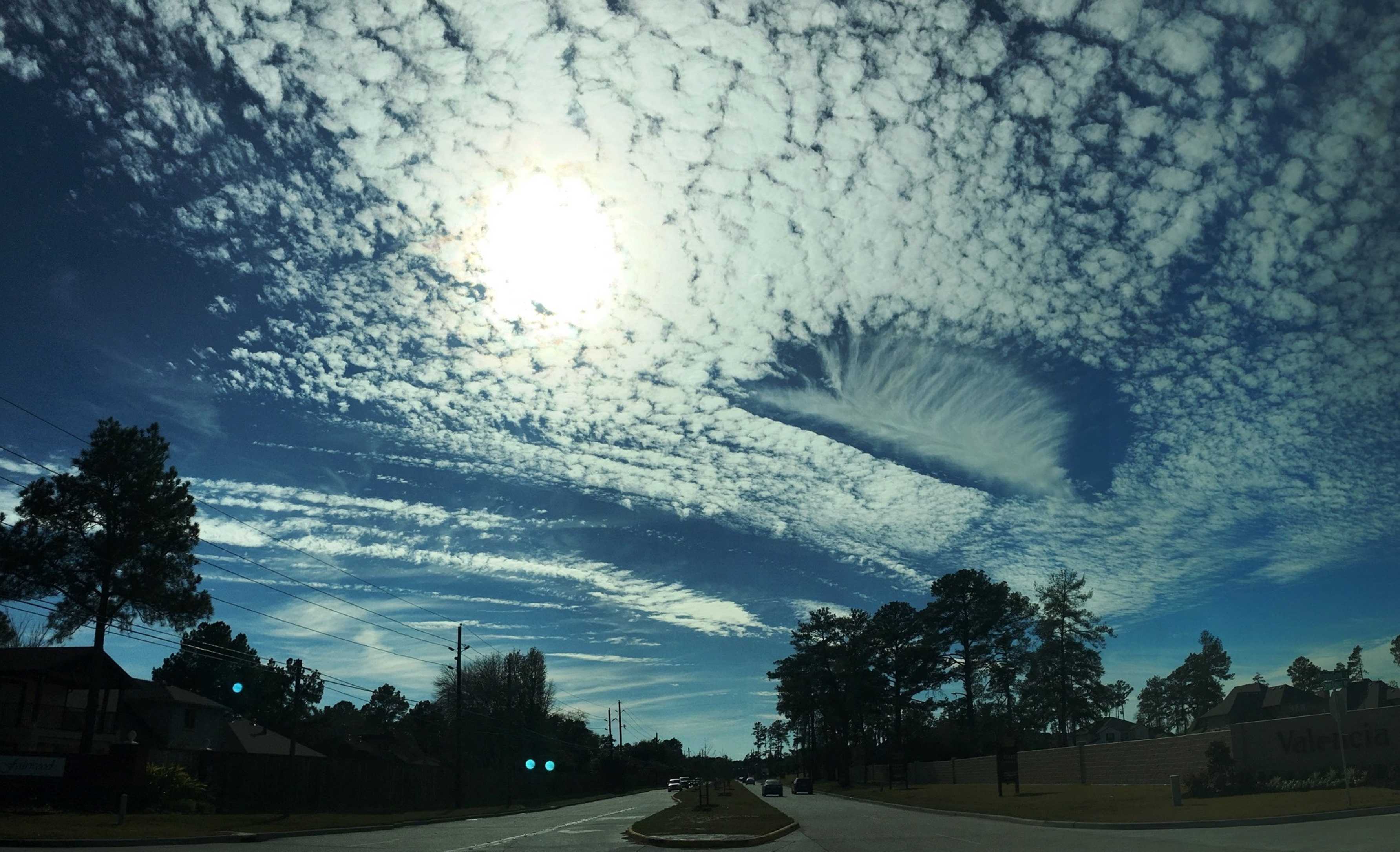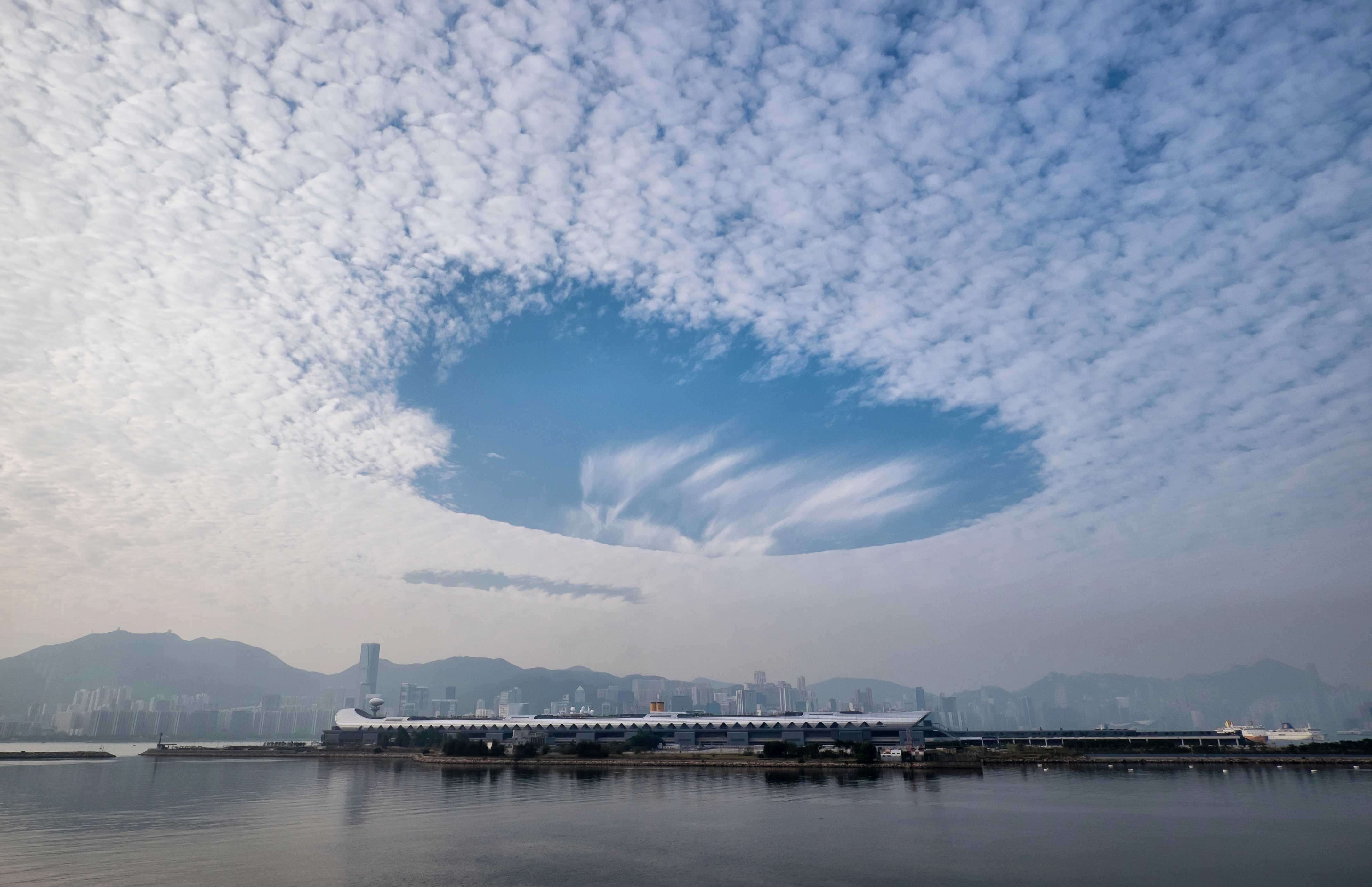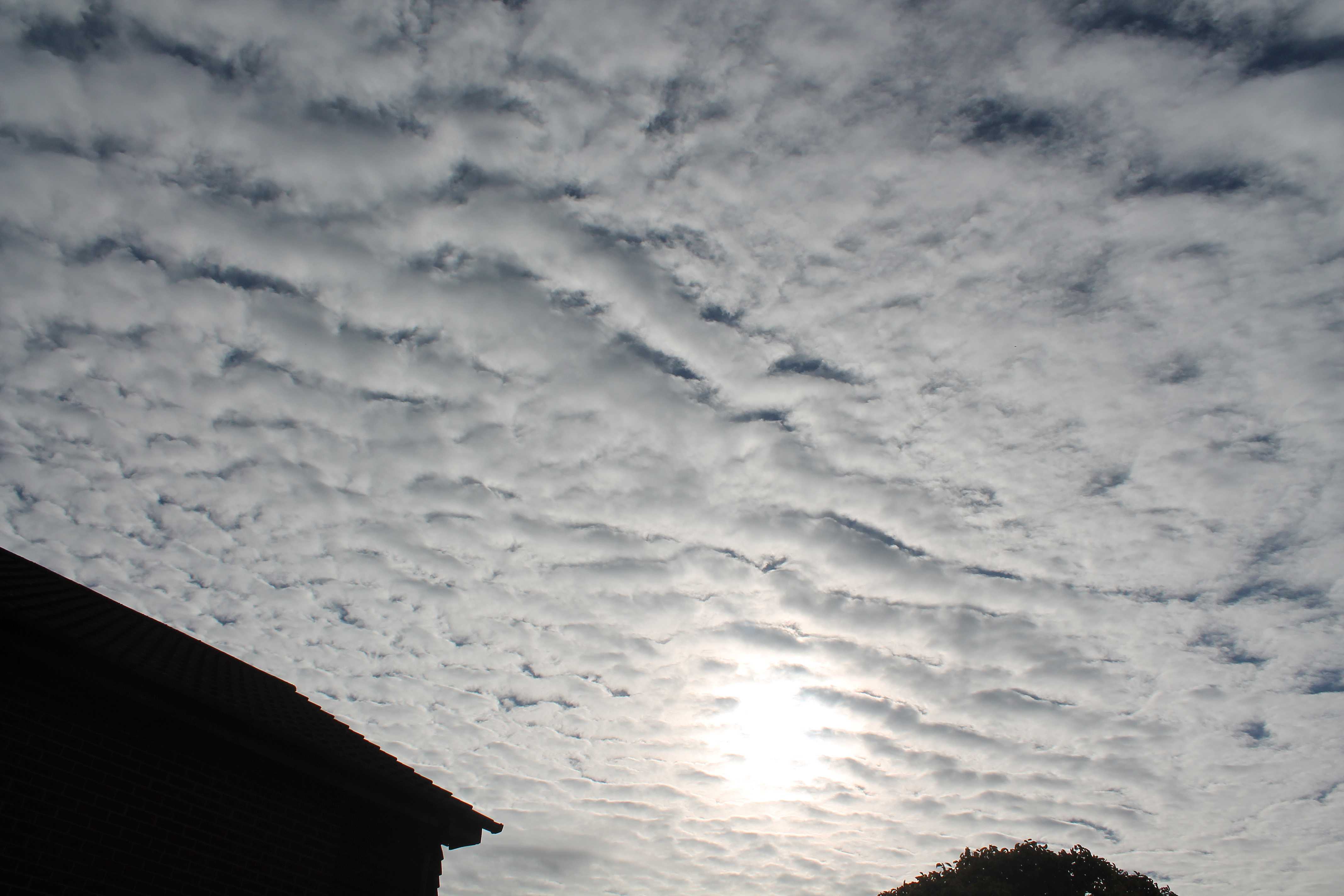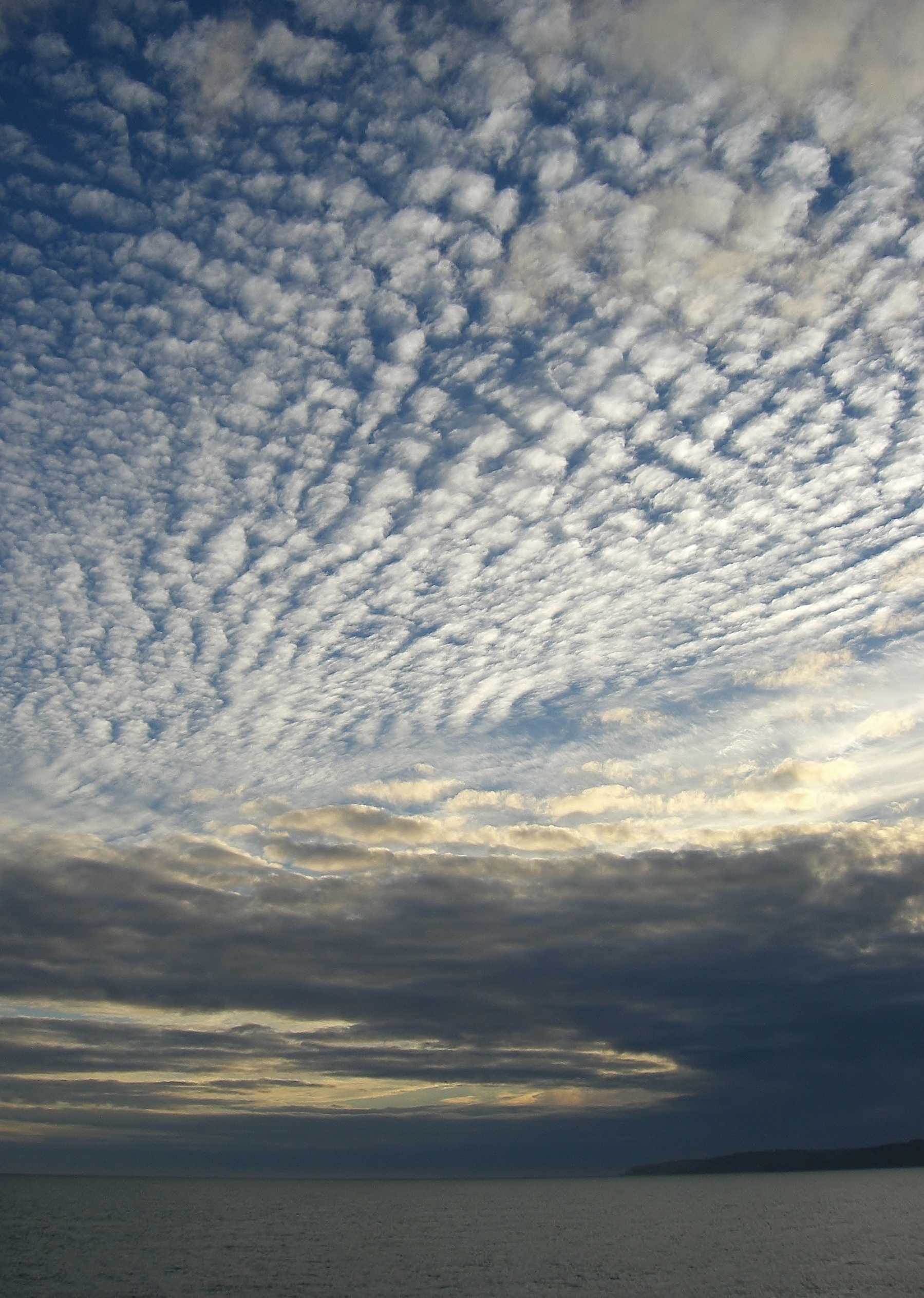© Everett Harrison
Cypress, Texas, United States of America
Latitude: 29° 59' 58'' N
Longitude: 95° 38' 28'' W
17 January 2016 1535 (Local Time)
Camera direction: towards SW
Image P/S code: S.4.16
Image I.D.: 5683
CL = 0, CM = 3, CH = 1
-

Altocumulus stratiformis perlucidus translucidus cavum
The main cloud in this picture is Altocumulus stratiformis perlucidus translucidus cavum. This medium-level cloud is identified as Altocumulus by the rounded masses that have an apparent width between 1° and 5°. It is in an extensive layer (stratiformis), has spaces between the cloud elements that allow the blue of the sky to be seen (perlucidus) and is sufficiently thin and translucent to reveal the position of the Sun (translucidus). The large, roughly circular hole just to the right of the centre is the supplementary feature cavum, popularly known as a “fallstreak hole” or “hole-punch cloud”. Within the hole there are fallstreaks of ice crystals falling to a lower level. An aircraft dissipation trail (distrail) lies diagonally from the top right of the image through the right side of the fallstreak hole. There is also a small amount of Cirrus in the image. Straight filaments suggest at least some is of the species fibratus. It is likely that some, or even all, of the cloud lines in the lower left of the image are old, persistent contrails (Cirrus homogenitus) that are starting to lose their identity as such.
The supplementary feature cavum is formed when glaciation occurs in a thin cloud layer consisting of supercooled water droplets in a liquid state at a temperature below 0 °C. As the supercooled water drops glaciate, the resulting ice crystals fall from the cloud layer to a lower level. The cloud hole typically grows larger with time as the glaciation process continues.
Links in the image description will highlight features on the image. Mouse over the features for more detail.
© Everett HarrisonCypress, Texas, United States of AmericaLatitude: 29° 59' 58'' NLongitude: 95° 38' 28'' W17 January 2016 1535 (Local Time)Camera direction: towards SWCL = 0, CM = 3, CH = 1Image P/S code: S.4.16Image I.D.: 5683
Altocumulus stratiformis perlucidus translucidus cavum
This thin, translucent and extensive layer of cloud is Altocumulus stratiformis translucidus. In the top part of the picture it also displays the variety perlucidus, as there are the gaps between the cloud elements. However, the most striking feature is the large, roughly circular hole beneath which there is virga. The large hole is the supplementary feature cavum, popularly known as a “fallstreak hole” or “hole-punch cloud”. The full classification for the cloud is therefore Altocumulus stratiformis perlucidus translucidus cavum.
Also of note is a linear gap in the cloud between the fallstreak hole and the horizon. This is an aircraft dissipation trail, or distrail, formed as a result of an aircraft flying through the cloud layer. Informally this is sometimes known as a “canal cloud”. It later transformed into a circular-type hole (see the accompanying time lapse).
The supplementary feature cavum is formed when glaciation occurs in a thin cloud layer consisting of supercooled water droplets that are in a liquid state and at a temperature below 0 °C. As the supercooled water drops glaciate, the resulting ice crystals fall from the cloud layer to a lower level as virga, or fallstreaks. The resulting cloud hole typically grows larger with time while the glaciation process continues.
Links in the image description will highlight features on the image. Mouse over the features for more detail.
© Tsz Cheung LeeKwun Tong, Hong Kong, ChinaLatitude: 22° 18' 41'' NLongitude: 114° 13' 38'' E19 January 2015 0830 (Local Time)Camera direction: towards SWCL = 0, CM = 3, CH = 0Image P/S code: P.4.16Image I.D.: 5167
Altocumulus stratiformus translucidus
The cloud is an extensive thin sheet (species stratiformis) with merged cloud elements arranged in broadly parallel lines (variety undulatus). The sky is easily visible through the layer, identifying the variety translucidus. The blue of the sky can also be seen in the spaces between the lines of merged elements (variety perlucidus). The colour is predominantly white, with some light grey colouration near the back edge due to the cloud being thicker and to the low angle of the Sun.
Links in the image description will highlight features on the image. Mouse over the features for more detail.
© Frank Le BlancqLa Pulente, St Brelade, JerseyLatitude: 49° 11' 18'' NLongitude: 2° 13' 33'' W25 November 2012 1626 (Local Time)Camera direction: towards SWCL = 0, CM = 3, CH = 0Image P/S code: P.4.1Image I.D.: 5479
Altocumulus stratiformis translucidus perlucidus undulatus
This layer of medium-level cloud is Altocumulus. Its rounded masses and rolls have an apparent width of between 1° and 5° and there is some shading. The specific species of this Altocumulus is classified as stratiformis, due to the cloud’s extensive coverage of the sky. The sheet of cloud is sufficiently translucent to reveal the position of the Sun, and so it is also of the variety translucidus. In places there are spaces between the cloud elements, which also indicates the variety perlucidus, and the enlongated and broadly parallel rolls indicate that the variety undulatus also applies.
Links in the image description will highlight features on the image. Mouse over the features for more detail.
© George AndersonWokingham, England, United Kingdom of Great Britain and Northern IrelandLatitude: 51° 25' 36'' NLongitude: 0° 49' 26'' W31 August 2014 0850 (Local Time)Camera direction: towards SECL = 0, CM = 3, CH = /Image P/S code: P.4.7Image I.D.: 5172Altocumulus stratiformis translucidus perlucidus undulatus
The relatively small white elements in the upper two thirds of this image are identified as Altocumulus. These elements make up an extensive sheet (species stratiformis). To this identification are added the varieties translucidus (the elements are sufficiently translucent to reveal the position of the Sun), perlucidus (small gaps between the elements reveal blue sky) and undulatus (separate elements are arranged in broadly parallel lines).
The Altocumulus and some higher cirriform cloud were advancing from the west (left in the photo) ahead of a weak warm front. Also visible are traces of Cumulus fractus (light grey in the top right) and a layer of dark grey Stratocumulus stretching towards the horizon (lower part of the image).
Links in the image description will highlight features on the image. Mouse over the features for more detail.
© Frank Le BlancqNear GuernseyLatitude: 49° 23' 43'' NLongitude: 2° 28' 13'' W02 August 2008 2012 (Local Time)Camera direction: towards NWCL = 8, CM = 3, CH = /Image P/S code: P.4.8Image I.D.: 5168
